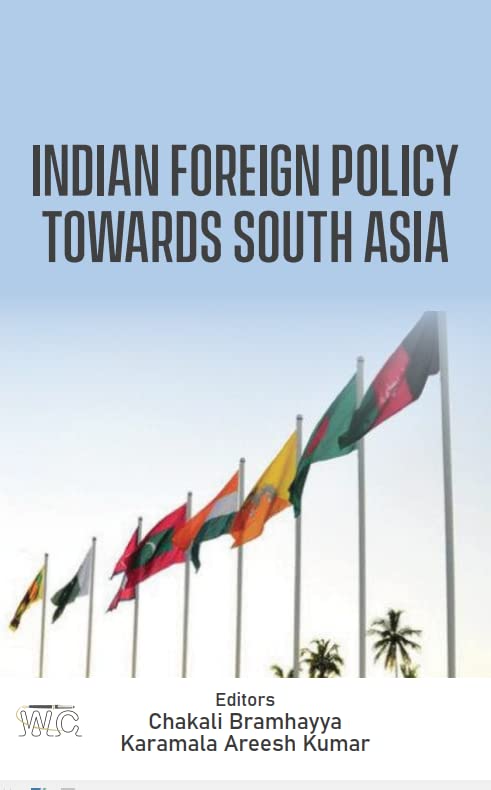
The book “Indian Foreign Policy towards South Asia” is an edited volume by Dr. Chakali Bramhayya from Indira Gandhi National Tribal University (IGNTU), Amarkantak and Dr. Karamala Areesh Kumar from St. Joseph’s College (Autonomous), Bengaluru. The authorship of the book covers a wide range of research institutes and universities across the country. The edited volume consists of thirteen chapters on various foreign policy issues of the South Asian region.
Chapter One, titled “India’s Foreign Policy Interests in South Asia: Understanding Neighborhood Strategy“, by Dr. Chakali Bramhayya, Dr. Karamala Areesh Kumar and Hari Yadav. G, gives an outlook of India’s immediate Neighborhood policy under Modi’s foreign policy doctrine. The chapter also focuses on the geographical importance of the region, the lack of an integration process, the India-Pakistan rivalry and the emergence of extremism in the South Asian region. Chapter Two, titled “India’s Foreign Policy towards South Asia” by Ishfaq Ahmad Akhoon focuses on India’s approach primarily towards Nepal, Sri Lanka and Pakistan. The author explains the Kashmir issue as the major challenge for cooperation between India-Pakistan in this chapter.
Chapter Three, titled “Impact of Globalization on Indian Foreign Policy”, by Harsha Sahu analyzes globalization’s impact on Indian foreign policy. The author argues how the FDI, foreign borrowings, the balance of payments and information technology influences Indian foreign policy. Chapter Four, titled “India’s South Asia Policy under Modi Government”, Dr.Anil Kumar provides a historical evolution of Indian foreign policy from non-alignment to multi-alignment. In this chapter, the author argues that under the BJP government, India adopted a more empirical, realistic and aggressive foreign policy.
Chapter Five, titled “The Role of Indian Perceptions in India’s Foreign Policy towards Pakistan after the Kargil Conflict”, by Sraban Kumar Nahak focuses on the Kargil conflict between India and Pakistan. The author also highlights the major issues between India and Pakistan such as the water sharing dispute, illegal infiltration, drug trafficking, and arms race after the Kargil conflict. Chapter Six, titled “The China-Pakistan Economic Corridor: Emerging Security Concern and Geopolitical Challenges for India”, by Prakash Raj examines the geopolitics of the CPEC. The author discusses the dilemmas of the China-Pakistan economic corridor and its implications for India.
Chapter Seven, titled “Indo-Pak Relations: A Threat to the Peace in South Asia Region”, by Dr. K. Udayasree gives an overview of India-Pakistan relations and its significance in the geopolitics of South Asia. The author also highlights the role of Russia and China in the region. The author believes that religion, culture and the Kashmir issue are major determinants of India-Pakistan relations.
Chapter Eight, titled “An Assertive China and India’s Growing Challenges in Nepal”, by Abhijit Dihidar provides an overview of the trilateral relationship between India-China-Nepal. The author points out how both superpowers use Nepal for political and security interests. Chapter Nine, titled “Post-Colonial Indo-Sri Lanka Relations: A Sri Lankan Perspective”, by Asantha Senevirathna gives an overview of Indo-Sri Lanka relations. The author also discusses the issues of Illegal Fishing in the Maritime Boundary, The Indo-Sri Lanka Free Trade Agreement (ISFTA), and Emerging Power politics in the Indian Ocean Region. Chapter Ten, titled “Conflicting Foreign Policy of India and China over Sri Lanka”, by Maria Catherine provides a brief overview of the geographical significance of Sri Lanka for India and China.
Chapter Eleven, titled “Migration and Refugee Conflict between India and Bangladesh, ” by Athulya Pradeep and Edberg D. Cheeran provides a brief overview of the mass migration of illegal Bangladeshis to India. Chapter Twelve, titled “Geopolitics of Belt and Road Initiative of China: Implications for India”, by Dr. Karamala Areesh Kumar, Hari Yadav. G and Dr. Chakali Bramhayya explain the geopolitics and strategic interests of China’s Belt and Road Initiative. The author also highlights India’s stand and countering mechanism by collaborating with other major powers in the region. Chapter Thirteen, titled “SAARC Remains Only a Dream of Its Founder”, Dr. K. Somasekhar focuses on the functioning and relevance of SAARC in the region. The author highlights the failure of SAARC by providing empirical evidence of hostile relations, conflicts and a lack of regional integration process.
The book covers a variety of issues in the South Asian region from India’s foreign policy perspective. It highlights India’s bilateral engagements with neighbouring countries, geopolitics, the role of China, Russia and the US, terrorism, illegal trade and trafficking, border disputes, the impact of globalization and the regional integration process. Hence, I believe the book will help students, academicians and policy analysts in South Asia.
(Sana Zulfikar Ahmed is a Scholar from the National Law School of India University, Bengaluru, Karnataka, India)
Book: Indian Foreign Policy Towards South Asia
Edited by: Dr. Chakali Bramhayya and Dr. Karamala Areesh Kumar
Publishers: Writers Choice, New Delhi
Year of Publication: 2022
Price: ₹ 950 (Hardcover)
SW Ratings: ****
